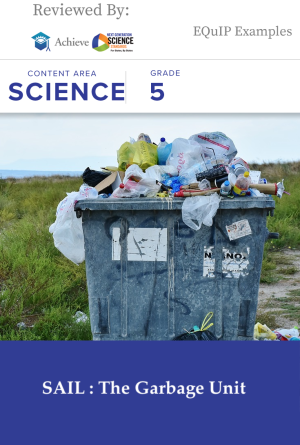
This unit was developed by the Science And Integrated Language (SAIL) team at New York University. The goal of the SAIL project is to develop a yearlong fifth-grade NGSS-aligned curriculum with a specific focus on English learners (ELs). Based on a conceptual framework for science and language integration (Lee, Goggins, Haas, Januszyk, Llosa, & Grapin, 2019; Lee, Llosa, Grapin, Haas, & Goggins, 2019; Lee, Quinn, & Valdés, 2013), the curriculum aims to promote both science learning and language learning for all students, including ELs. The research team, comprised of NGSS writers, science content experts, and applied linguists, developed the SAIL curriculum in collaboration with classroom teachers in New Jersey public schools. The SAIL project is supported by the National Science Foundation (NSF DRL-1503330). Currently, the team is developing an enhanced version of the SAIL curriculum that integrates computational thinking and modeling (NSF DRL-1742138).
Lee, O., Goggins, M., Haas, A., Januszyk, R., Llosa, L., & Grapin, S. (2019). Making everyday phenomena phenomenal: Next Generation Science Standards-aligned instructional materials using local phenomena with diverse student groups. In P. Spycher & E. Haynes (Eds.), Culturally and linguistically diverse learners and STEAM: Teachers and researchers working in partnership to build a better tomorrow (pp. 211-228). Charlotte, NC: Information Age Publishing.
Lee, O., Llosa, L., Grapin, S. E., Haas, A., & Goggins, M. (2019). Science and language integration with English learners: A conceptual framework guiding instructional materials development. Science Education, 103(2), 317-337.
Lee, O., Quinn, H., & Valdés, G. (2013). Science and language for English language learners in relation to Next Generation Science Standards and with implications for Common Core State Standards for English language arts and mathematics. Educational Researcher, 42(4), 223-233.
Score: 8
Awarded the NGSS Design Badge
Discipline: Physical Science, Life Science
Length: Unit
Year Reviewed: 2019
The anchoring phenomenon of this unit is that the school, home, and neighborhood make large amounts of garbage every day. In answering the driving question of the unit, “What happens to our garbage?”, students investigate a series of subquestions (e.g., “What is that smell?” and “What causes changes in the properties of garbage materials?”) that address a targeted set of physical science and life science performance expectations. Over nine weeks of instruction, students develop a coherent understanding of the structure and properties of matter to make sense of the anchoring phenomenon and to answer the driving question.
This unit was developed with a specific focus on English learners by using an engaging, local phenomenon and design principles that capitalize on the mutually supportive nature of science and language learning.
The NGSS Design Badge is awarded only to the version of this unit that was reviewed. If any modifications are made to this unit, the revised version cannot be promoted as having earned the badge.
Link to Materials: To access the supplementary materials for the Garbage Unit including PowerPoint slides, videos, supply lists, summative assessments, visit the unit page here.
 Reviews & Questions
Reviews & Questions
- - Any -
- Questions
- Reviews
- Log in or register to post comments